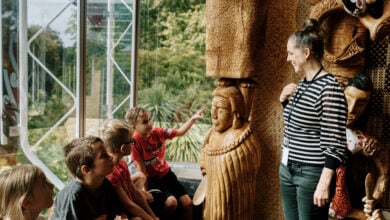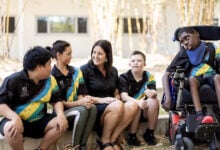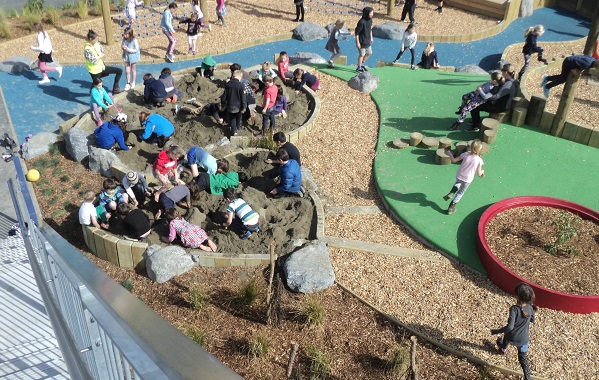
Fish ’n chip evenings, pool parties and a teachers’ trip to Melbourne were all part of the meticulous planning to ensure a successful merging of two primary schools in Lyttelton, Canterbury.
The schools, Lyttelton Main and Lyttelton West (already old and somewhat decrepit), were both damaged in the catastrophic earthquake of February, 2011, with repair bills and strengthening work estimated at more than $2M. But rather than fix the buildings, the Ministry of Education (MOE) decided to merge the two and re-house them in brand new buildings on the Oxford Street site of Lyttelton Main.
Repair work was not the only factor; the MOE deemed the school-age population of Lyttelton, a port town of 3,000, too small to support both schools. At the time, each school had around 125 enrolled students. The Lyttelton Main site was chosen as the continuing site because of constraints associated with Lyttelton West, including underground tunnels, which would limit development.
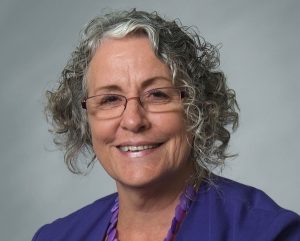
Lyttelton West principal of 21 months, Diana Feary, was appointed principal designate in September, 2013, and tasked with managing the transition process, a time she concedes was challenging. The schools officially morphed into Lyttelton Primary School – Te Kura Tuatahi o Ōhinehou, in May, 2014, but for two years, the staff and students remained split across two sites, causing all sorts of practical and operational difficulties.
“Existing on two sites created difficulties around meetings and communication. Staff were constantly moving between sites, and this was particularly true for leadership. It was not uncommon for people who were meeting to find themselves on different sites, and this was also true for visitors!” says Ms Feary.
Getting staff together who did not know each other was the first challenge. “We planned staff only days and staff meetings where we focussed on shared teaching practices, and the emerging design of our new school. We brought the children together through activity days, assemblies, creative times, sports days, fun days, and vertical groupings. This also allowed teachers and children to get to know each other.
“Shared professional learning development provided by CORE Education was critical to enable teachers to develop understandings of the changing face of education. Attending a conference in October, 2014, was a great catalyst for change for the teachers, as well as providing time for teachers to get to know each other. The trip to Melbourne in July, 2015, was pivotal in our collective understandings of collaborative teaching, and from then we were able to begin to develop a pedagogy that we believed would work well for our new school, and for our children. CORE also provided learning opportunities for parents through workshops and visits to schools.”
The Education Review Office (ERO) praised the leaders and board in managing the split site, saying, “Delays in the school’s opening and building delays affected the smooth running of the school. Some parents have voiced their concerns about changes to learning and teaching program. Throughout this unsettled period of change, trustees, senior leaders and teachers have kept a clear focus on student achievement and wellbeing.” And despite the difficulties, more than 80 per cent of students were achieving at or above National Standards in reading, writing and mathematics.
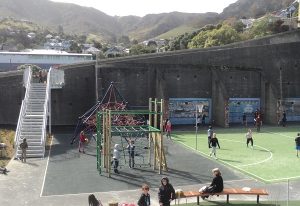
Visits between sites, (roughly 30 minutes’ walk) began in May, 2014, for shared assemblies, learning and play times. Social occasions were organised too, so that parents from both schools could get to know each other. “We held fish ’n chip evenings, pool parties, and provided forums and workshops for parents to learn about modern learning practice and the changing face of education which has an expectation of student agency.”
On the first day of term two this year, 25 staff and 212 students finally congregated in their shiny new school on Oxford Street.
The build had been far from straightforward with the first design rejected and the process starting over in early 2015. The actual build began in June, 2015, took ten months and came in at $14.9 million – a sum that included remediation work on the historic Gaol Wall which borders the site. Lyttelton has a rich history and the school’s playing field was once the site of a gaol for “murderers, lunatics and debtors” with seven men hanged inside the walls. The town itself is hilly with narrow streets and buildings dating back to the mid-1800s, making restoration work difficult and costly.
Today, the wall is the only clue to the site’s bleak history. The school, a stark, two-level building, is thoroughly modern – and tangible evidence of a town getting back on its feet. All four learning studios can accommodate 75 children and three teachers, each with two break out spaces, a teachers’ room, a kitchen and an art space.
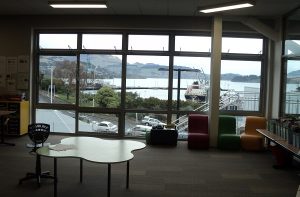
“The learning spaces are open and spacious with lots of glass and amazing views (across Lyttelton Harbour), and the buildings – decorated in a neutral palette – are warm and welcoming,” says Ms Feary. “We think the design of our learning spaces is conducive to children developing self-managing skills to support their learning.”
Ms Feary, a teaching professional of three decades’ experience, is a fan of MLE pedagogy. “Our MLE is cleverly designed to provide interesting areas for teaching and learning, and independent and collaborate activities. The learning areas on each floor are open which allows children and teachers to move between the areas. This allows for grouping according to needs and interests, and for children of various year levels to collaborate in their learning.”
One example of this is the school’s writing program. The teachers of years five to eight collaborate, grouping children according to their identified needs or interests. Another is the five-week review process which entails teachers from each floor (years one to four and years five to eight) meeting to talk about the progress and achievement of all their children in reading, writing and maths. “This means that all teachers have knowledge and understanding of attitudes, dispositions as well as progress and achievement. Using Google Drive to share data is critical in this initiative.”
Design for the school’s playground was the work of both landscape architects and children, and includes an astro turf court, two climbing frames and a creative play area with slides and sandpits. There are stairs rising to the grass play area on the other side of the gaol wall.
Ms Feary has now resigned from LPS and will finish in January, 2017. “My focus since my appointment has been on bringing two schools together in spirit, philosophy and in consistent practice. I am proud of our transition and of how well teachers, staff and children have adapted to their amazing new environment. This has been due to our persistent focus on understanding the changes we needed to make, and holding fast to our beliefs. It has been a time of incredible challenge, hard work, and a commitment to doing the best for the children, regardless of our circumstances. It has also been a privilege – not many educators have the opportunity to develop a new school. I am looking forward to taking some time out before I decide on what next. I am having a ‘gap’ year!”
Board of trustees chairwoman Bridget O’Brien said she was “very sorry to see her go”. She said Ms Feary had overseen a very difficult and complex period for primary schooling in Lyttelton, and had given outstanding service.
“The board wants to acknowledge the incredible work load that Diana has shouldered. We also want to thank her for all that she has achieved in managing the transition while maintaining excellent student achievement results.”
Recruitment for a new principal is underway.




